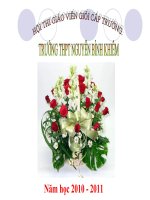- Trang chủ >>
- Y - Dược >>
- Truyền nhiễm
BỆNH DỊCH tả (BỆNH TRUYỀN NHIỄM)
Bạn đang xem bản rút gọn của tài liệu. Xem và tải ngay bản đầy đủ của tài liệu tại đây (12.64 MB, 88 trang )
BỆNH DỊCH TẢ
DỊCH TẢ
NGUYÊN NHÂN
DỊCH TỄ
BỆNH SINH
LÂM SÀNG
XÉT NGHIỆM
CHẨN ĐOÁN
ĐIỀU TRỊ
BIẾN CHỨNG
CHẨN ĐỐN PHÂN BIỆT
PHỊNG BỆNH
NGUYÊN NHÂN
Vibrio cholerae
Ancient Texts Describe Cholera
500-400 BC: Sanskrit writings
500 BC: Hippocrates
200 AD: Galen
900 AD: Rhazes, Islamic physician
Sanskrit, Arabic, and Chinese writings
dating back 2,000 years
Filipo Pacini
1854: identified comma-shaped
bacterium
Named it Vibrio cholerae
5 Pandemic: 1881-1896
th
Began in India, spread east and west
1883 - Robert Koch cultured V. cholerae
Good sanitation – did not affect much of
Europe
Diagnosis and quarantine – kept it out of
US
Prevented contact between those with
exposure to unsanitary conditions (on ships)
and those on mainland
Identification
Vibrios are highly
motile, gram-negative,
curved or commashaped rods with a
single polar flagellum,
whose natural habitat is
usually salt or fresh
water.
Vibrio cholerae: bacteriology
• Curved gram negative
bacillus
• Single polar flagellum
• Flagellar H antigen and
somatic O antigen.
• O antigen used to classify
V. cholerae into serogroups
(01 and 0139 are most well
known)
• Two biotypes of 01
(classical and El Tor)
The Gram-negative outer membrane(1)
Lipopolysaccharide
n
O-antigen
Highly variable
Core
• Heptoses
• Ketodeoxyoctonic acid
Lipid A
• Glucosamine disaccharide
• Beta hydroxy fatty acids
Profile of vibrio cholerae
Gram-negative
Highly motile; polar flagellum
Brackish rivers, coastal waters
Associate with plankton and algae
Proliferate in summers
Cholera toxin
Pathogenic and nonpathogenic
strains
206 serogroups
Classification: Serogroups and
Biotypes
The species V. cholerae can be sub-classified into 200
serogroups based on the O antigen of LPS
(lipopolysaccharide).
Only O1 and O139 strains have been implicated in the cholera
syndrome.
Classification: O1 Serogroup
2 Biotypes: El Tor and Classical
V. cholerae O1 are further divided
into 2 major subserotypes (Inaba
and Ogawa).
The basis for subtyping is 3
antigenic determinants of the O
antigen structure of their LPS.
These serotypes are differentiated
in agglutination and vibriocidal
antibody tests on the basis of their
dominant heat-stable
lipopolysaccharide somatic
antigens.
The serotypes share one
determinant known as the A
antigen.
In addition, Inaba strains
express the C antigen
whereas Ogawa strains
express the B antigen .
Classification: O1 Antigen
Strains Causing Epidemics
2 main serogroups carry set of virulence
genes necessary for pathogenesis
O1
Classical: 1 case per 30-100 infections
El Tor: 1 case per 2-4 infections
O139
Contained in India, Bangladesh
NGUYÊN NHÂN
Vibrio cholerae O1:
Classical
Biogroups (biovars, biotypes)
Eltor
Serotypes (A,B,C factors of O-antigen)
Ogawa (A+B+C)
Hikojima (A+B+C): unstable
Inaba (A+C)
Dịch tễ học (Epidemiology)
Epidemiology as defined by Last is “the study
of the distribution and determinants of healthrelated states or events in specified populations,
and the application of this study to the prevention
and control of health problems”
DỊCH TỄ
Có 7 trận dịch từ 1817 đến nay
1905: V.cholerae 01 eltor được phát hiện tại trại cách ly
Eltor thuộc Sinai Peninsula của Egypt
1961-nay: đại dịch lần 7 lan từ Indonesia do V.cholerae
01 eltor gây ra.
Vi khuẩn dịch tả sống dai dẳng trong nước, ở nhiệt độ 20300C có thể sống đến 14 ngày ở nước sạch
(dechlorinateed tap water), 20 ngày ở nước ngọt tự nhiên
(untreated fresh), 30 ngày ở nước biển.
19/10/1992: V. cholerae 0 139 ở Madras, miền nam Ấn độ
Chưa phát hiện được ổ chứa ở súc vật
Đường lây: phân miệng
John Snow and the Pump Handle
John Snow and
cholera in 1854
London
John Snow
• John Snow is
credited by
many with
developing the
modern field of
epidemiology
Broad Street Pump
Map led Snow to believe that Broad
Street pump was cause of outbreak
Those affected drank from pump
Sewage probably contaminated well
Removal of pump handle - end of
outbreak
Skepticism about Snow’s findings
London in the 1850’s
• Germ theory of disease not widely
accepted
• People lived in very crowded
conditions with shared water and
toilets facilities outside









